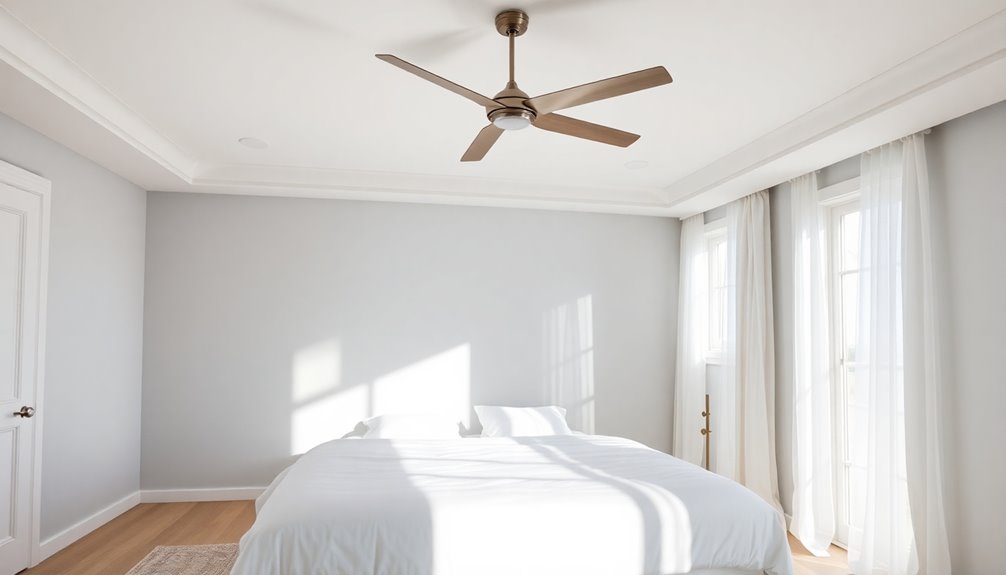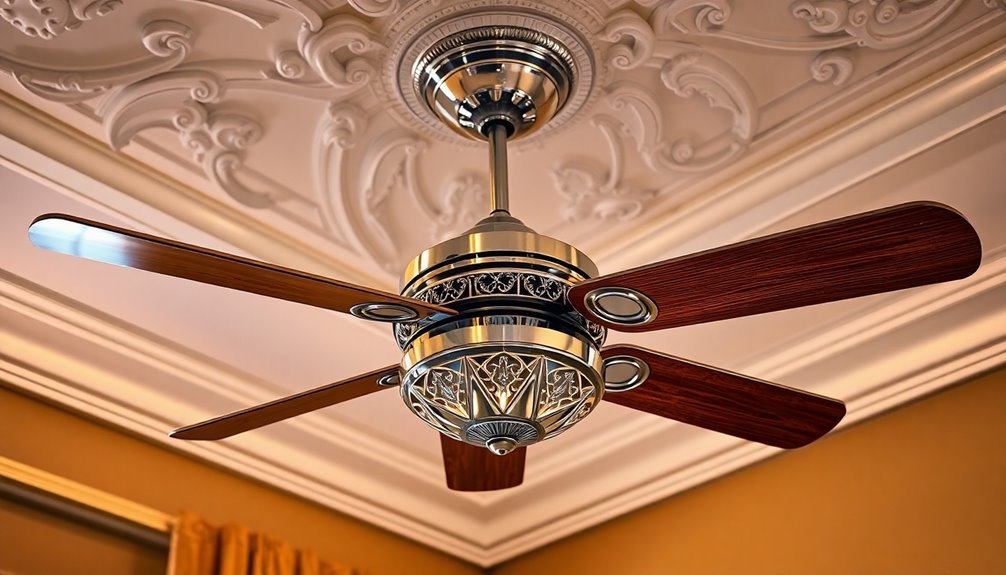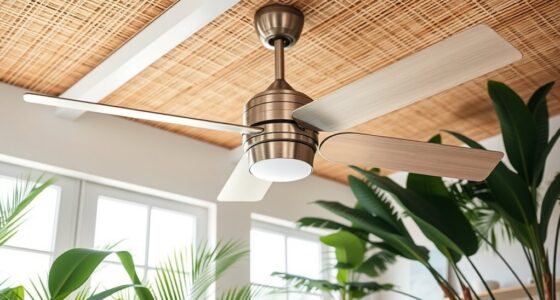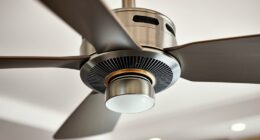When choosing a ceiling fan for your master bedroom, size matters. For rooms up to 200 square feet, go for a fan with a blade span of 44-50 inches. If your space is larger, like 400 square feet, you'll want a fan that measures 52-60 inches across. Make sure your ceiling height is at least 8 feet for ideal airflow. Don't forget to take into account blade design and pitch, as these impact efficiency. Choosing the right fan can enhance comfort and style while saving energy. Stick around to discover more tips for finding the perfect fan for your space.
Key Takeaways
- For a standard master bedroom (12×12 ft), choose a ceiling fan with a blade span of 36-50 inches for effective air circulation.
- In larger bedrooms (over 14×16 ft), select a fan with a minimum blade span of 52 inches to ensure efficient airflow.
- For rooms up to 400 sq ft, an ideal fan size is 50-54 inches to enhance comfort and energy efficiency.
- Ensure the ceiling height is at least 8 feet for optimal airflow; lower ceilings may require low-profile fans.
- Regular maintenance, including cleaning and checking balance, is essential for optimal fan performance and longevity.
Recommended Fan Sizes for Bedrooms

When choosing a ceiling fan for your master bedroom, size really matters for both comfort and efficiency. Proper fan sizing is essential to achieve ideal airflow and enhance your comfort level.
For a standard master bedroom measuring 12×12 feet, you should look for ceiling fan sizes with a blade span between 36 to 50 inches. This range guarantees effective air circulation without overwhelming the space.
If your master bedroom is larger, specifically over 14×16 feet, aim for a fan size with a blade span of at least 52 inches. This will help maintain efficient air circulation and enhance energy efficiency.
In master bedrooms up to 400 square feet, a fan size of 50 to 54 inches is typically ideal, providing a comfortable environment while reducing the need for heating and cooling systems.
For smaller bedrooms, keep in mind that fans with a diameter of 29 to 36 inches work best, making sure that the airflow doesn't overpower the area.
Measuring Your Bedroom Space

Accurately measuring your bedroom space is vital for selecting the right ceiling fan. Start by measuring the length and width of your master bedroom to calculate the total room size in square footage. For instance, a room measuring 12×15 feet equals 180 square feet. If your room size is up to 200 square feet, look for a ceiling fan with a blade span of 44 to 50 inches to guarantee effective air circulation.
Next, measure the ceiling height. You'll want to install the fan at least 8 feet above the floor for ideal airflow and safety.
If your master bedroom features a unique shape or layout, consider using multiple fans or specific placements to enhance cooling throughout the space.
Additionally, pay attention to CFM (Cubic Feet per Minute) ratings when selecting your fan. Higher CFM ratings indicate better airflow, which is essential for maintaining comfort in your bedroom.
Ceiling Height Considerations

When choosing a ceiling fan, consider your ceiling height to guarantee ideal performance and safety.
If your ceilings are lower than 8 feet, you might want to look into low-profile fans, while standard heights often require downrod mounts for proper airflow.
Adjusting fan height is essential to maintain comfort and avoid collisions, so take these factors into account before making your selection.
Ideal Ceiling Height Range
For best ceiling fan performance in your master bedroom, aiming for a ceiling height between 8 to 9 feet is ideal. This height range allows for maximum airflow and comfort without obstruction. When you install your fan, make sure it's at least 7 feet above the floor to maintain safe clearance for occupants. If your ceiling exceeds 9 feet, you'll likely need downrods to achieve the proper fan height and enhance airflow efficiency. For ceilings under 8 feet, consider low-profile fans to guarantee adequate clearance and effective air circulation.
Here's a quick reference table to help you understand ceiling height considerations:
| Ceiling Height | Recommended Fan Type | Installation Tips |
|---|---|---|
| Under 8 feet | Low-profile fans | Ensure minimal clearance |
| 8 to 9 feet | Standard fans | Ideal for maximum airflow |
| 9 to 10 feet | Standard + downrods | Maintain proper fan height |
| Over 10 feet | Downrods needed | Check for airflow efficiency |
| Sloped ceilings | Specialized kits | Ensure proper airflow direction |
Downrod Length Adjustments
Ceiling height plays a significant role in determining the right downrod length for your ceiling fan. For ceilings over 8 feet, you'll likely need a downrod to guarantee the fan is installed at an ideal height of 7 to 9 feet above the floor, optimizing airflow and safety.
For example, with a 10-foot ceiling, a 24-inch downrod is typically necessary to maintain proper clearance.
If you're dealing with ceilings under 8 feet, low-profile fans can be a great solution, as they allow for direct ceiling mounting without a downrod.
However, if your ceiling is sloped, you may require an angled-ceiling adapter, which can affect the downrod length needed to keep the fan at the right height.
It's essential to verify that your downrod length allows for at least 12 to 14 inches of clearance from the ceiling. This distance helps prevent airflow blockage and promotes effective circulation throughout the room.
Low-Profile Fan Options
If you've got a ceiling under 8 feet high, low-profile fans are your best bet for maintaining comfort and safety in your master bedroom.
These ceiling fans are specifically designed to provide adequate airflow while ensuring you won't accidentally bump into the blades. They typically mount directly to the ceiling, optimizing air circulation in spaces with low ceilings.
When selecting a low-profile fan, consider these important factors:
- Minimum Clearance: Aim for a clearance of at least 7 feet from the floor to the fan blades to enhance safety and comfort.
- CFM Rating: Look for fans with a sufficient Cubic Feet per Minute (CFM) rating to effectively circulate air throughout your master bedroom.
- Sleek Designs: Choose low-profile fans that feature sleek designs, complementing your room's aesthetics while maintaining functionality.
Energy Efficiency and Fan Size

Choosing the right ceiling fan size for your master bedroom is crucial for maximizing energy efficiency. For spaces ranging from 200 to 400 square feet, a fan size of 52 to 60 inches is recommended. This guarantees ideal air circulation, allowing you to feel comfortable without cranking up the thermostat. Additionally, a properly sized ceiling fan can work in conjunction with a heat pump system, enhancing overall energy efficiency in your home.
Pay attention to the CFM rating; a higher rating improves airflow, which can lead to lower thermostat settings and reduced energy costs.
To further enhance energy efficiency, consider a fan with a blade pitch between 12 to 15 degrees. This design promotes better airflow, making it ideal for maintaining a comfortable temperature in your master bedroom.
Properly sized ceiling fans can greatly lower your heating and cooling energy needs, ultimately saving you money on your energy bills.
Don't forget about seasonal adjustments! Reversing the fan direction in winter helps circulate warm air, making your space cozier without overusing your heating system. Additionally, incorporating smart technology into your ceiling fan can optimize its efficiency and performance.
Blade Design and Functionality

When choosing a ceiling fan, consider the blade pitch, as a steeper angle can greatly boost airflow efficiency.
You might also want to explore reversible blade options, which let you switch finishes for a fresh look with the changing seasons.
Both factors play an essential role in enhancing both the functionality and aesthetic of your master bedroom.
Blade Pitch Importance
Understanding the importance of blade pitch in a ceiling fan can greatly enhance your comfort and energy efficiency. The angle at which the blades are set plays a vital role in airflow efficiency.
Here's why you should consider blade pitch when selecting a ceiling fan for your master bedroom:
- Air Movement: Fans with steeper pitches, ideally between 12 to 15 degrees, markedly improve air movement, ensuring your space feels comfortable without over-relying on HVAC systems.
- Energy Costs: A fan with a lower blade pitch may not circulate air adequately, leading to increased energy costs. This could force you to crank up your heating or cooling systems more than necessary.
- Ideal Blade Pitch: Choosing a fan with the ideal blade pitch can lead to considerable energy savings over time. It helps maintain your desired room temperature efficiently, reducing the strain on your HVAC systems.
Reversible Blade Options
Reversible blade options greatly enhance a ceiling fan's functionality, allowing you to adapt airflow according to the season. With a simple switch, you can change the airflow direction, providing cooling in the summer and improved heat distribution in the winter. This feature is particularly beneficial in your master bedroom, ensuring year-round comfort.
The blade pitch also plays a role in optimizing performance. Ideally, a pitch of 12 to 15 degrees maximizes airflow efficiency, whether you're cooling or heating the space. By utilizing reversible blades, you can contribute to energy savings by working in harmony with your heating and cooling systems.
Additionally, many reversible blade fans offer aesthetic versatility, presenting different finishes or colors on each side. This allows you to match your ceiling fan to your room decor easily, enhancing the overall look of your master bedroom.
When considering ceiling fan size, remember that the right fan, combined with reversible blades, can greatly improve your comfort and energy efficiency. Seasonal adjustments become effortless, and you can enjoy the benefits of performance optimization throughout the year.
Installation and Mounting Options

Choosing the right installation and mounting option for your ceiling fan is important to guarantee peak performance and safety. Your ceiling height plays a significant role in determining which mounting option works best for you. Here are the main options:
- Flush Mount: Ideal for standard ceiling heights of 8 to 9 feet, it guarantees the fan blades are positioned 7 to 9 feet above the floor for optimal airflow.
- Downrod Mounts: Perfect for ceilings higher than 9 feet, these allow for proper clearance and airflow. Make certain to select the appropriate downrod length based on your ceiling height.
- Sloped Ceilings: If your ceiling isn't flat, you'll need an angled-ceiling adapter for proper installation and function, making sure the fan hangs correctly.
Before installation, always verify that your electrical box is fan-rated to support the weight and vibrations of the ceiling fan. This step is essential for guaranteeing safety and stability during operation.
Aesthetic Choices and Style

A ceiling fan can be a striking focal point in your master bedroom, blending functionality with style. When choosing fan styles, consider how they complement your existing decor. Modern ceiling fans with sleek designs work well in contemporary spaces, while ornate fans suit traditional aesthetics. Blade color plays a vital role too; wood finishes can add warmth, while metallic tones introduce a fresh, modern touch. Additionally, transitional ceiling fan designs offer a versatile option, seamlessly bridging the gap between classic and contemporary styles. These designs often feature a mix of materials and finishes, making them adaptable to various decor themes. By choosing a fan that harmonizes with your room’s color palette and furniture, you can create a cohesive and inviting atmosphere.
If you have a larger master bedroom, think about fans with integrated lighting. They not only provide airflow but also enhance illumination, making the space feel more inviting. Opting for an odd number of blades can add dynamic visual appeal, creating a unique focal point that draws the eye. In contrast, even-numbered blades can offer a more balanced look.
Make sure your fan style fits the room's proportions. A larger fan can dominate a spacious area, while a smaller fan might appear out of place.
Frequently Asked Questions
Is a 52 Inch Fan Too Big for a 12X12 Room?
Yes, a 52-inch fan is generally too big for a 12×12 room.
It can overpower the space, creating excessive air movement that might make you uncomfortable. You'd likely find it hard to maintain a cozy atmosphere with such a large fan.
Instead, opt for a fan around 44 inches. This size will effectively circulate air without overwhelming the room, keeping your environment pleasant and visually appealing.
Is a 42-Inch Fan Big Enough for a Bedroom?
Imagine your bedroom as a cozy boat gently swaying on calm waters. A 42-inch ceiling fan can be just the right anchor for smaller spaces, ensuring a pleasant breeze without overwhelming the deck.
It's perfect for rooms up to 144 square feet, providing comfort and balance.
However, if your space feels like a vast ocean, you might want a larger fan to keep that invigorating air flowing throughout the entire cabin.
Is a 60 Inch Ceiling Fan Too Big for a Bedroom?
A 60-inch ceiling fan can be too big for some bedrooms, especially if the room's size is under 400 square feet.
You'll want to guarantee it doesn't create drafts or excessive airflow, which could make the space uncomfortable.
If you've got a larger room, a 60-inch fan might work well, but always consider the room's dimensions and design to maintain an aesthetically pleasing environment.
Balance is key for comfort and style!
What Size Ceiling Fan for 12X12 Bedroom?
For a 12×12 bedroom, you'll want a ceiling fan with a blade span of 36 to 50 inches for ideal air circulation.
Look for a fan with a high CFM rating to keep the space cool during warmer months.
Make sure it's centered and at least 7 feet above the floor for safety.
If your ceiling's under 8 feet, a flush mount fan will maintain adequate clearance and airflow.
Consider a reversible motor for year-round comfort.
Conclusion
Choosing the right ceiling fan for your master bedroom can transform your space from stuffy to serene. A fan that's too small leaves you feeling warm, while one that's too large can overwhelm the room's aesthetics. By measuring your space, considering your ceiling height, and selecting an energy-efficient model, you strike the perfect balance between comfort and style. So, go ahead and elevate your bedroom experience—not just with airflow, but with a design that speaks to you.









